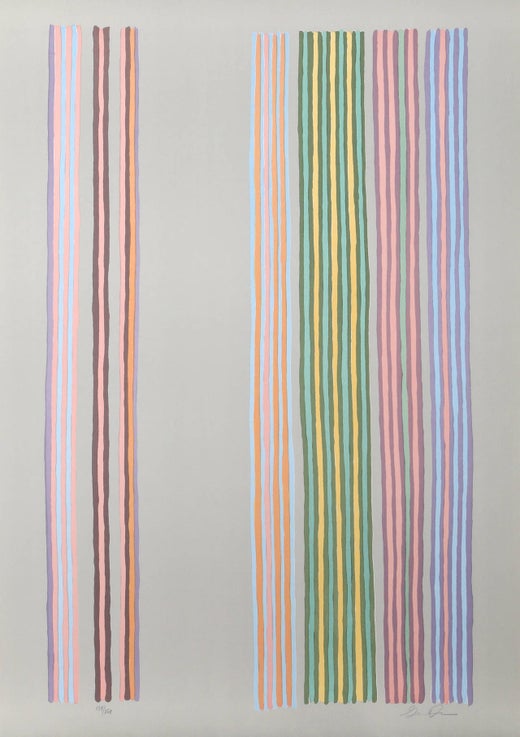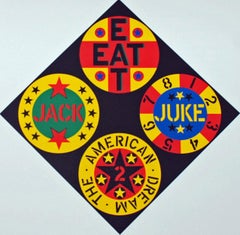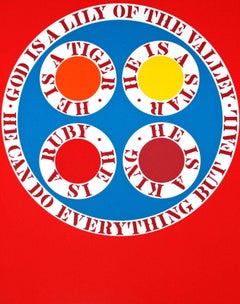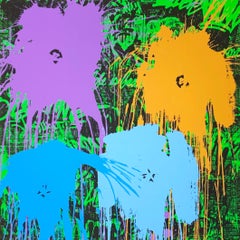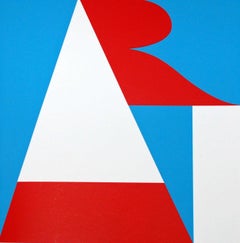Want more images or videos?
Request additional images or videos from the seller
1 of 13
Gene DavisRoyal Curtain1980
1980
$2,495List Price
About the Item
- Creator:Gene Davis (1920-1985, American)
- Creation Year:1980
- Dimensions:Height: 35 in (88.9 cm)Width: 26.5 in (67.31 cm)
- Medium:
- Period:
- Condition:
- Gallery Location:Washington, DC
- Reference Number:Seller: GDRC011stDibs: LU544316555672
Gene Davis
Davis was born in Washington D.C. in 1920 and spent nearly all his life there. Before he began to paint in 1949, he worked as a sportswriter, covering the Washington Football Team and other local teams. Working as a journalist in the late 1940s, he covered the Roosevelt and Truman presidential administrations, and was often President Truman's partner for poker games. His first art studio was in his apartment on Scott Circle; later he worked out of a studio on Pennsylvania Avenue. Davis's first solo exhibition of drawings was at the Dupont Theater Gallery in 1952, and his first exhibition of paintings was at Catholic University in 1953. A decade later he participated in the "Washington Color Painters" exhibit at the Washington Gallery of Modern Art in Washington, DC, which traveled to other venues around the US, and launched the recognition of the Washington Color School as a regional movement in which Davis was a central figure. The Washington painters were among the most prominent of the mid-century color field painters. Though, he worked in a variety of media and styles, including ink, oil, acrylic, video, and collage, Davis is best known by far for his acrylic paintings (mostly on canvas) of colorful vertical stripes, which he began to paint in 1958. The paintings typically repeat particular colors to create a sense of rhythm and repetition with variations. One of the best-known of his paintings, "Black Grey Beat" (1964), owned by the Smithsonian American Art Museum reinforces these musical comparisons in its title. The pairs of alternating black and grey stripes are repeated across the canvas, and recognizable even as other colors are substituted for black and grey, and returned to even as the repetition of dark and light pairs is here and there broken by sharply contrasting colors. In 1972 Davis created Franklin's Footpath, which was at the time the world's largest artwork, by painting colorful stripes on the street in front of the Philadelphia Museum of Art, and the world's largest painting, Niagara (43,680 square feet), in a parking lot in Lewiston, NY. His "micro-paintings", at the other extreme, were as small as 3/8 of an inch square. For a public work in a different medium altogether, he designed the color patterns of the "Solar Wall," a set of tubes filled with dyed water and backlit by fluorescent lights, at the Muscarelle Museum of Art at the College of William and Mary in Williamsburg, Virginia. Davis began teaching in 1966 at the Corcoran School of Art, where he became a permanent member of the faculty. His works are in the collections of, among others, the Corcoran Gallery of Art, the Solomon R. Guggenheim Museum, The Phillips Collection in Washington, DC, the Walker Art Center in Minneapolis, MN, The Governor Nelson A. Rockefeller Empire State Plaza Art Collection in Albany, NY, and the Smithsonian American Art Museum. He died on April 6, 1985 in Washington, DC.
About the Seller
5.0
Platinum Seller
Premium sellers with a 4.7+ rating and 24-hour response times
Established in 1989
1stDibs seller since 2017
615 sales on 1stDibs
Typical response time: 1 hour
Authenticity Guarantee
In the unlikely event there’s an issue with an item’s authenticity, contact us within 1 year for a full refund. DetailsMoney-Back Guarantee
If your item is not as described, is damaged in transit, or does not arrive, contact us within 7 days for a full refund. Details24-Hour Cancellation
You have a 24-hour grace period in which to reconsider your purchase, with no questions asked.Vetted Professional Sellers
Our world-class sellers must adhere to strict standards for service and quality, maintaining the integrity of our listings.Price-Match Guarantee
If you find that a seller listed the same item for a lower price elsewhere, we’ll match it.Trusted Global Delivery
Our best-in-class carrier network provides specialized shipping options worldwide, including custom delivery.You May Also Like
Victor Vasarely "Axo-Charga" Hand-Signed Limited Edition Serigraph, Framed
By Victor Vasarely
Located in Miami, FL
"AXO-CHARGA" BY VICTOR VASARELY (1906-1997)
Serigraph on Black Paper ⚜ Signed ⚜ Numbered ⚜ Framed
A VISIONARY MASTERWORK OF OP ART
"Axo-Charga" is a striking original serigraph by V...
Category
1970s Op Art Abstract Prints
Materials
Screen, Paper
$3,575 Sale Price
35% Off
H 40.125 in W 32.375 in D 1.125 in
Victor Vasarely "Stri-Arct-2" 1975 Op Art Serigraph, Hand Signed & Numbered
By Victor Vasarely
Located in Miami, FL
VICTOR VASARELY – "STRI-ARCT-2"
⚜ Serigraph ⚜ Hand Signed and Numbered ⚜ Edition of 250 (Total 300) ⚜ Conservation Framed
GEOMETRIC VIBRATIONS IN COLOR
Created in 1975, “Stri-Arct-2...
Category
1970s Op Art Abstract Prints
Materials
Screen
$3,375 Sale Price
25% Off
H 31.5 in W 29.625 in D 1.125 in
Jean Dubuffet - Le Hochet - Original Screenprint
By Jean Dubuffet
Located in Collonge Bellerive, Geneve, CH
Jean Dubuffet
Banque de L'Hourloupe
Original Card with a title card
Original edition of 350 numbered sets with 30 hors commerce
Dimensions: 25 x 16 cm
Screen printed by Kelpra Studios, London Editions Alecto, London 1967
Jean Dubuffet (1901 - 1985)
Jean Dubuffet was born on July 31, 1901, in Le Havre, France. He attended art classes in his youth and in 1918 moved to Paris to study at the Académie Julian, which he left after six months. During this time, Dubuffet met Raoul Dufy, Max Jacob, Fernand Léger, and Suzanne Valadon and became fascinated with Hans Prinzhorn's book on psychopathic art. He traveled to Italy in 1923 and South America in 1924. Then Dubuffet gave up painting for about ten years, working as an industrial draftsman and later in the family wine business. He committed himself to becoming an artist in 1942.
Dubuffet's first solo exhibition was held at the Galerie René Drouin, Paris, in 1944; the Pierre Matisse Gallery gave him his first solo show in New York in 1947. During the 1940s, the artist associated with André Breton, Georges Limbour, Jean Paulhan, and Charles Ratton...
Category
1960s Abstract Impressionist Abstract Prints
Materials
Screen
$1,410
H 9.85 in W 6.3 in D 0.04 in
Jean Dubuffet - La Mouche - Original Screenprint
By Jean Dubuffet
Located in Collonge Bellerive, Geneve, CH
Jean Dubuffet
Banque de L'Hourloupe
Original Card with a title card
Original edition of 350 numbered sets with 30 hors commerce
Dimensions: 25 x 16 cm
Screen printed by Kelpra Studios, London Editions Alecto, London 1967
Jean Dubuffet (1901 - 1985)
Jean Dubuffet was born on July 31, 1901, in Le Havre, France. He attended art classes in his youth and in 1918 moved to Paris to study at the Académie Julian, which he left after six months. During this time, Dubuffet met Raoul Dufy, Max Jacob, Fernand Léger, and Suzanne Valadon and became fascinated with Hans Prinzhorn's book on psychopathic art. He traveled to Italy in 1923 and South America in 1924. Then Dubuffet gave up painting for about ten years, working as an industrial draftsman and later in the family wine business. He committed himself to becoming an artist in 1942.
Dubuffet's first solo exhibition was held at the Galerie René Drouin, Paris, in 1944; the Pierre Matisse Gallery gave him his first solo show in New York in 1947. During the 1940s, the artist associated with André Breton, Georges Limbour, Jean Paulhan, and Charles Ratton...
Category
1960s Abstract Abstract Prints
Materials
Screen
$1,410
H 9.85 in W 6.3 in D 0.04 in
Graphisms & 2. 1980, paper, silk screen, 15x21 cm
Located in Riga, LV
Graphisms & 2. 1980, paper, silk screen, 15x21 cm
Maris Argalis (1954-2008)
Born in Riga.
1971. - graduated the Janis Rosenthal Riga Art School.
Ongoing...
Category
1980s Surrealist More Prints
Materials
Paper, Screen
$357 Sale Price
20% Off
H 5.91 in W 8.27 in D 0.04 in
Graphisms & 3. 1980, paper, silk screen, 15x28 cm
Located in Riga, LV
Graphisms & 3. 1980, paper, silk screen, 15x28 cm
Maris Argalis (1954-2008)
Born in Riga.
1971. - graduated the Janis Rosenthal Riga Art School.
Ongoing...
Category
1980s Surrealist More Prints
Materials
Paper, Screen
$357 Sale Price
20% Off
H 5.91 in W 11.03 in D 0.04 in
The New Year graphisms & 12. 1979, paper, silk screen, 15x21.5 cm
Located in Riga, LV
The New Year graphisms & 12. 1979, paper, silk screen, 15x21.5 cm
Maris Argalis (1954-2008)
Born in Riga.
1971. - graduated the Janis Rosenthal Riga Art...
Category
1970s Conceptual More Prints
Materials
Paper, Screen
$357 Sale Price
20% Off
H 5.91 in W 8.47 in D 0.04 in
Graphisms & 4. 1979, paper, silk screen, 15x28 cm
Located in Riga, LV
Graphisms & 4. 1980, paper, silk screen, 15x28 cm
Maris Argalis (1954-2008)
Born in Riga.
1971. - graduated the Janis Rosenthal Riga Art School.
Ongoing...
Category
1980s Surrealist More Prints
Materials
Paper, Screen
$357 Sale Price
20% Off
H 5.91 in W 11.03 in D 0.04 in
Black/White/Black
By Ellsworth Kelly
Located in Philadelphia, PA
Black/White/Black, 1970
Screenprint in colors on Special Arjomari
Edition of 75 42 1/4 x 29 3/4 in.
Publisher: Gemini G.E.L., Los Angeles
Category
Late 20th Century More Prints
Materials
Screen
Tage Slawischer Kulture
Located in Spokane, WA
Original poster: Linen-backed original poster "Tage Slawischer Kultur" done by the artist Rasch. The days of Slavic Culture. This would cover the countries knowns as Slavic language speaking people: Russia, the Ukraine, Belarus, Poland, Czech Republic, Slovakia, Bulgaria, Slovenia, Croatia, Serbia, Bosnia and Herzegovina, Macedona and Montenegro.
A drama mask in white rests on a leaning abstract color panel that could be a scarf or material that blends the styles and colors inlocking together to form a cultural pattern. A dark blue background brings the image to the forefront of this vintage original poster.
Every year on May 24th all Slavic countries commemorate Saints Cyril...
Category
1960s Abstract Geometric Abstract Prints
Materials
Screen
More From This Seller
View AllBlack Diamond American Dream #2
By Robert Indiana
Located in Washington, DC
Artist: Robert Indiana
Title: Black Diamond American Dream #2
Portfolio: The American Dream
Medium: Serigraph
Year: 1997
Edition: 395
Sheet Size: 22" x 17"
Image Size: 9 7/8" x 9 7/8...
Category
1990s Abstract Prints
Materials
Screen
God is Lily of the Valley, from The American Dream
By Robert Indiana
Located in Washington, DC
Artist: Robert Indiana
Title: God is Lily of the Valley
Portfolio: The American Dream
Medium: Serigraph
Year: 1997
Edition: 395
Sheet Size: 22" x 17"
Image Size: 17" x 13 3/8"
Signat...
Category
1990s Abstract Prints
Materials
Screen
Flowarh$ - II (A)
By Mr. Brainwash
Located in Washington, DC
Artist: Mr. Brainwash
Title: Flowarh$ - II (A)
Portfolio: Flowarh$
Medium: Silkscreen edition print on paper
Date: 2021
Edition: PP 2/3 (aside from the edition of 55)
Frame Size: 31 ...
Category
2010s Street Art Abstract Prints
Materials
Screen
Art, from The American Dream
By Robert Indiana
Located in Washington, DC
Artist: Robert Indiana
Title: Art
Portfolio: The American Dream
Medium: Serigraph
Year: 1997
Edition: 395
Sheet Size: 22" x 17"
Image Size: 14" x 14"
Signature: Unsigned
Category
1990s Abstract Abstract Prints
Materials
Screen
Indiana in Lewiston
By Robert Indiana
Located in Washington, DC
Artist: Robert Indiana
Title: Indiana in Lewiston
Medium: Silkscreen on wove paper
Date: 1991
Edition: 150
Sheet Size: 46 1/2" x 26 3/4"
Signed: Hand signed in pencil
Category
1990s Abstract Prints
Materials
Screen
Mississippi, from The American Dream
By Robert Indiana
Located in Washington, DC
Artist: Robert Indiana
Title: Mississippi
Portfolio: The American Dream
Medium: Serigraph
Date: 1997
Edition: 395
Sheet Size: 22" x 17"
Image Size: 16 1/8" x 14"
Signature: Unsigned
Category
1990s Abstract Abstract Prints
Materials
Screen
Recently Viewed
View AllMore Ways To Browse
Picasso Pomme
Pierre Soulages On Sale
Poems Dans Le Ciel
Quarry Robert Rauschenberg
Rafael Soriano
Richard Serra Etching
Richter P19
Robert Indiana 1968
Robert Indiana Signed Hope
Roderick Mead
Roger Nellens
Ron Adams
Rothko Signed Prints
Roy Lichtenstein Apple
Shorewood Reproductions
St Louis Symphony
Stella Frank Plates
Swan Engraving
